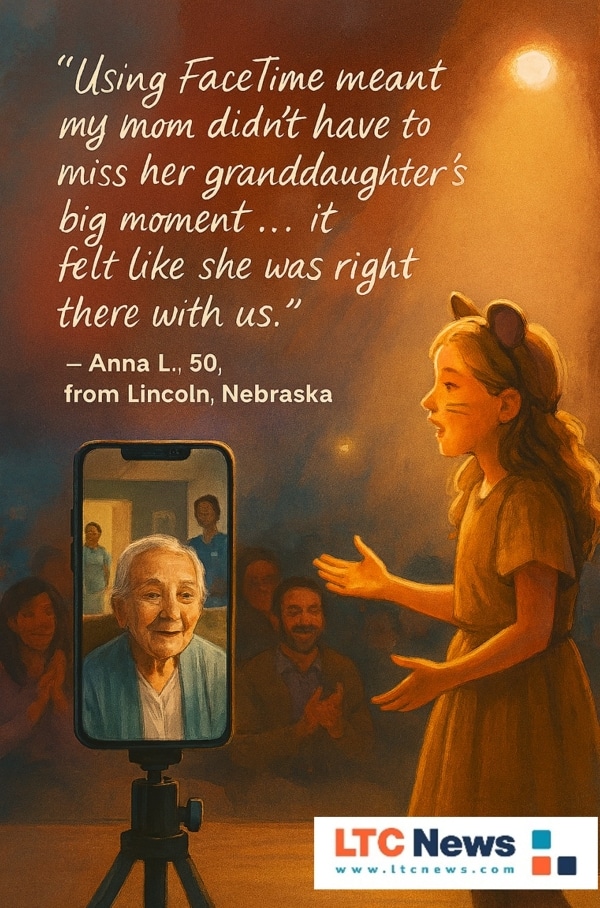Inside Look: Technology is Redefining Family Connections in Long-Term Care

You're probably doing your best despite an aging parent's ongoing and growing needs. You are not alone in watching your parent age; many people know how deeply this journey tugs at your heart. One day you’re juggling your own job and family; the next, you’re coordinating doctors’ appointments, medications, and caregiving schedules for Mom or Dad.
Whether your parent lives at home with help or in an assisted living or nursing facility, you’re constantly trying to stay organized, informed, and available. It’s not just a logistical challenge — it’s an emotional one. Not to mention the financial reality of long-term care.
Feeling overwhelmed is not unique. Millions of adult children in your shoes are searching for ways to stay connected, reduce stress, and ensure their parent’s care stays consistent and compassionate. That’s why new tools and strategies — from digital care plans to mobile connectivity like eSIM Plus — can be a lifeline.
Technology allows you to coordinate more easily, communicate more clearly, and focus on what matters most: spending meaningful time with your parent while knowing they’re safe and supported.
What Long-Term Care Really Means
If you are already dealing with long-term care with a loved one, you know the consequences extended care has on the entire family. If you have an aging parent, you need to prepare for what is to come, since it is often not a matter of "if" but rather "when" and "how long."
Long-term care (LTC) refers to ongoing support for individuals who have difficulty with daily activities over an extended period. Unlike short-term medical treatment, LTC is about maintaining dignity and quality of life — helping with bathing, dressing, eating, using the bathroom, personal hygiene, mobility, medication management, and other essential tasks. It may include supervision if they have dementia.
Extended care can take place in several settings:
- At Home: With in-home aides or visiting nurses, allowing your parent to stay in familiar surroundings.
- Assisted Living and Memory Care Facilities: Blending independence with daily support and supervision.
- Nursing Homes: Providing intensive medical and personal care for those with more extensive needs.
Knowing these options ahead of time helps you plan and protect your parent’s quality of life. Find out if they have a Long-Term Care Insurance policy. If not, can one be purchased at their age and health? If insurance is not an option, understanding how extended care will be paid for when the time comes will help alleviate the stress before the crisis actually occurs.
The LTC News Cost of Care Calculator can show you how the costs of extended care services can vary by location and type of care — an essential step for making informed choices when finding care. You can also use the LTC News Caregiver Directory to search for caregivers and facilities.
The Challenges You Face as a Family Caregiver
Being a caregiver — even from a distance — brings unique obstacles:
- Coordination of Care: Multiple doctors, therapists, and family members need to stay in sync.
- Communication Gaps: Miscommunication can lead to missed appointments or medication errors.
- Access to Information: You need timely updates about medical records and care plans.
- Stress and Burnout: Caregiving can take a toll on your physical and emotional health as you balance their needs with your own.
Recognizing these challenges is the first step to managing them. With the right tools, you can make the process less stressful and more effective.
How Technology is Transforming Long-Term Care
Technology is changing how families care for aging parents. Remote monitoring devices, telehealth services, and digital care platforms let you stay informed and respond faster when something changes.
One emerging option is eSIM technology, which allows you to stay connected without needing to juggle multiple SIM cards or incur high roaming charges. Tools like eSIM Plus can help you maintain seamless communication, ensuring that information flows smoothly and support is always available—no matter where you are. Plus, you can manage multiple devices, access real-time updates, and maintain communication with healthcare providers — whether you’re at work, at home, or traveling.
Staying Connected When You Live Far Away
Even if you live in another city or state, modern technology makes it possible to be present in your parents’ daily life and even their milestones. Tools such as FaceTime, Zoom, or Google Meet allow you to join family gatherings, watch grandkids perform at school events, or simply share coffee with Mom virtually every morning.
Some facilities now offer dedicated family portals or tablets for residents so you can:
- Video Chat Anytime: Schedule regular calls or drop in for quick check-ins.
- Attend Care Conferences Virtually: Join meetings with nurses and care teams without traveling.
- Share Special Moments: Stream graduations, birthdays, or religious services your parent can’t attend in person — or stream them into the facility so your loved one can “be there” remotely.
- Use Smart Displays: Devices like Amazon Echo Show or Meta Portal can remain on a shelf in your parents’ room, making it easy to “drop in” for face-to-face talks without complicated logins.
This connectivity helps reduce isolation for your parent and eases your own worry. When you see their face, hear their voice, and watch their expressions, you know immediately how they’re doing — even from miles away.
Studies have shown that older adults living in a long-term care facility can create the sense of being institutionalized, which may distance the residents from feeling that they live a ‘normal’ life. Your loved one can benefit from the social connection that today's technology provides, which is especially important when loved ones live far apart or have demanding work schedules.
Video calls and live-streaming have transformed how families stay present with loved ones in long-term care, especially for adult children living far away.
When in-person visits aren’t possible, video calls give families a vital lifeline—offering the social connection and emotional support their loved one needs to feel engaged and maintain a better quality of life.
Why Staying Connected Matters
Timely communication can make a significant difference in your parents’ well-being. eSIM technology offers a simple, reliable way for family caregivers and healthcare professionals to stay aligned:
- Real-Time Updates: Receive instant notifications about appointments, medications, or health alerts.
- Enhanced Coordination: Multiple caregivers can share one secure communication network.
- Flexibility: Switch between mobile networks easily when traveling or coordinating care across regions.
- Cost Savings: Reduce roaming charges and eliminate multiple SIM cards.
- Reliability: Ensure emergency calls and critical communications aren’t interrupted.
Practical Tips to Lighten Your Load
Even with the best technology, caregiving is still personal. These strategies can help you stay organized, strengthen your connection with your loved one, and protect your well-being:
- Create a Digital Care Plan: Keep an up-to-date schedule for medications, therapy sessions, and appointments so everyone involved knows what’s next.
- Use Telehealth Services: Save time and reduce stress by connecting with doctors and specialists from home.
- Stay Connected on the Go: Tools like eSIM Plus help you maintain seamless communication during travel or hospital visits.
- Leverage Video Calls and Messaging: FaceTime, Zoom, Google Meet, and even quick text messages can provide meaningful daily touchpoints, helping your loved one feel included and emotionally supported — especially when you can’t be there in person.
- Build a Support Network: Join online communities and local caregiver groups to exchange tips, share encouragement, and find emotional support.
Each of these steps can ease your workload, improve consistency, and help you deliver the attentive care your parent deserves. Staying in touch — even through short calls, messages, or video chats — reinforces your presence in their life and can have a powerful positive impact on their mood and quality of life.
Bringing Loved Ones Into Family Moments — Even from Afar
One of the most powerful uses of technology is its ability to bring your parent into life’s special moments — big or small — even when health or distance keeps them from attending in person. With simple tools like FaceTime, Zoom, or Google Meet, you can stream live video from weddings, birthday parties, graduations, holiday dinners, or even a grandchild’s first soccer game.
Facilities and family members are also using private Facebook groups, secure streaming links, and smart displays to make these experiences easy for older adults.
Staff at care communities can help set up a tablet or smart screen so your loved one can:
- Watch the toast at a wedding reception in real time.
- Sing “Happy Birthday” with the family from their room in an assisted living facility.
- Attend a grandchild’s school play or recital virtually.
- Join a family dinner table remotely on a weeknight just to stay part of the conversation.
These shared moments go far beyond a screen. They reduce loneliness, spark joy, and help your loved one feel truly included in the family’s ongoing story. Even quick video calls from everyday events — like a weekend breakfast or a walk in the park — reinforce your parents’ sense of belonging and connection.
Streaming family events allow older adults to stay emotionally connected to the people and milestones that matter most.

Share your thoughts and experiences about aging, caregiving, health, retirement, and long-term care with LTC News —Contact LTC News.
The Future of Long-Term Care
As the population ages, long-term care will become more tech-driven and patient-focused. Artificial intelligence, IoT devices, and mobile connectivity are already making care safer and more responsive. By using the latest technology, you’ll be better prepared to coordinate effectively, act quickly, and provide higher-quality support — no matter where you or your loved one lives.
The real question is how this care will be paid for. It may already be too late for your older parents to qualify for Long-Term Care Insurance. Still, it’s worth checking with an LTC Insurance specialist. Still, seeing your parents age is a powerful reminder to act now and ensure your own retirement plan includes long-term care coverage.
An LTC policy won’t stop aging or eliminate the need for extended care, but it will give you guaranteed, tax-free funds to pay for quality care — at home or in a facility. Planning now will reduce the burden on your children and their families, reducing stress and protecting your assets from the rising cost of long-term care.
- Learn More: Long-Term Care Insurance Education Center
Bringing it All Together
Staying connected isn’t just about convenience — it’s about safety, dignity, and peace of mind. With the right mix of planning and technology, you can turn one of life’s biggest challenges into a manageable, even empowering experience for you and your loved ones.
Aging can have consequences. But aging does not have to change a loved one's quality of life. Nor does aging have to become a family crisis for you, or for your loved ones decades from now.


